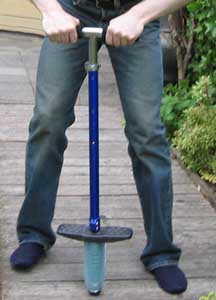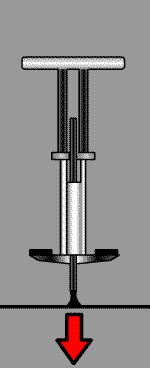Pogo stick: Difference between revisions
ClueBot NG (talk | contribs) m Reverting possible vandalism by 209.23.153.226 to version by Chzz. False positive? Report it. Thanks, ClueBot NG. (551232) (Bot) |
No edit summary |
||
| Line 4: | Line 4: | ||
[[Image:Pogo Stick.jpg|thumb|right|An adult holding a '''Pogo Stick'''.]] |
[[Image:Pogo Stick.jpg|thumb|right|An adult holding a '''Pogo Stick'''.]] |
||
Danny collins feeeeg |
|||
A '''pogo stick''' is a device for jumping off the ground in a standing position with the aid of a spring, used as a toy or exercise equipment. It consists of a pole with a handle at the top and footrests near the bottom, and a spring located somewhere along the pole. The spring joins two sections of the pole, which extends below the footpads. |
|||
The operator places his feet on the footpads while balancing on the pole, then jumps up or down with a bending action of the knees to add or subtract energy in the spring. When the spring is at full compression or extension, the operator is lifted by the recoil of the spring, being launched several inches or feet into the air. This process is repeated to maintain a periodic bounce. |
The operator places his feet on the footpads while balancing on the pole, then jumps up or down with a bending action of the knees to add or subtract energy in the spring. When the spring is at full compression or extension, the operator is lifted by the recoil of the spring, being launched several inches or feet into the air. This process is repeated to maintain a periodic bounce. |
||
Revision as of 13:24, 25 August 2011
- For the food, see Corn dog.
This article needs additional citations for verification. (August 2008) |

Danny collins feeeeg
The operator places his feet on the footpads while balancing on the pole, then jumps up or down with a bending action of the knees to add or subtract energy in the spring. When the spring is at full compression or extension, the operator is lifted by the recoil of the spring, being launched several inches or feet into the air. This process is repeated to maintain a periodic bounce.
The pogo stick can be steered by shifting one's weight off the centerline of the spring in the desired horizontal direction thus producing horizontal locomotion.
Inventors
A Spring stilt utilizing compression springs on each foot was patented in 1881 [1] by George H. Herrington of Wichita, Kansas "for leaping great distances and heights". This was an antecedent of the pogo stick as well as today's Spring stilts. A German patent was registered March 1920 [2] to Max Pohlig and Ernst Gottschall in Hannover for a device they called a "spring end hopping stilt". It is thought that the beginning two letters in these men's last names is where the name Pogo comes from.
The two handle pogo stick design was patented by George B. Hansburg,[3] in 1957. Hansburg described the origins of the Pogo name colloquially in a story of a young Burmese girl with the aforementioned name whose father had created a crude version of the device so that the daughter could travel to the local temple for prayers.[4] An earlier design with a single upright vertical handle [5]patented in 1955 posed something of a risk to the user's chin. Later improvements to the pogo stick have been made, including the Vurtego,[6] Flybar,[7] BowGo,[8] and the Up Wing pogo stick,[9] which allow operators to jump much higher than with a simple coil spring pogo stick. Back flips and other tricks are now possible on some of these newer sticks, which has contributed to the growth of the new sport of stunt pogo or extreme pogo. Yet no matter what improvements or different types are made, the basic design idea of man or woman riding on a spring remains the same.
Popularity
This section possibly contains original research. (July 2010) |
The popularity of the pogostick has fluctuated over the years. There have been shows performed with pogo sticks, marriages performed on them, jumping contests held, and world records set and reset numerous times.

See also
- Pogo effect, a dangerous oscillation produced by rocket engines
- Stilts
- Space hopper, another kind of bouncing toy
- Stunt pogo
- Powerbocking
- Pogo (dance)
- Commander Keen
References
External links
- Oscillations of a Pogo stick, Wolfram Demonstrations Project.
- [8], Pogo Sticks in the Press
- [9], History of Pogo Sticks
